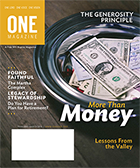
February-
March 2016
More Than Money
------------------
|






Twenty-First Century Stewardship
By Brad Ransom
For many people, money is a really awkward topic. Financial issues are private. How much money we have (or don’t have) isn’t something we like to discuss. Throw in the added layers of tithing and giving and the conversation really becomes uncomfortable. Ironically, the Bible has a great deal to say about money. According to the article “Money and Motives” by Greg Laurie, “Fifteen percent of everything Jesus ever taught was on the topic of money and possessions…more than His teachings on Heaven and Hell combined.”
I think the big difference comes in attitude. We need to stop looking at money from a human perspective and look at it from a biblical perspective. The teaching of Scripture regarding tithing and giving comes through the filter of stewardship. When we understand we are stewards (managers) of God’s resources, tithing isn’t a big deal. We aren’t giving our money away; we’re giving God’s money back to God. Exactly. (And that’s not a typo.) One hundred percent of everything we have belongs to God. When we tithe or give, we are only returning to God what is rightfully His. This is the concept of stewardship we should be living and teaching. I won’t belabor the point, but I will share some practical ideas to help people give more conveniently in our churches.
I’m well into my 50s, and I vividly remember the days of putting cash in envelopes at church, writing checks, and rolling coins to put into the offering plate. Those days are gone for most people. Since we live in a technology-driven society, churches need to find ways to adapt to the 21st century giver.
Besides passing the plate, most churches don’t have a strategy or system for stewardship. I believe we are missing an opportunity to receive donations from a large demographic in our population. If your typical church member’s age is 55 or older (generally), most donations will come by check, with a little cash. If this describes your church, you’re probably not missing many donations. If, however, the average age at your church is younger, especially 20 to 40-year-olds, remember they don’t use checks and don’t carry cash. By only passing the offering plate, you eliminate a large portion of potential income for your church. If you don’t believe me, just ask any 30-year-old.
To merge stewardship with technology, let me
suggest a few practical ideas any church can do:
-
Choose an annual month to emphasize stewardship. Teach stewardship, not giving or tithing.
-
Develop a stewardship system for your church. Think about every need your church has over the course of a year (regular budget items, general fund) as well as items such as capital stewardship campaigns, building funds, van funds, etc. Your stewardship system should include teaching moments before offerings. Take one minute to explain why people should give, and where money goes (besides paying bills, the pastor’s salary, and insurance). People need to know they are supporting the church and local ministry by giving, but they are also supporting missions, church planting, higher education, and more (if the church budget includes these things). Plan to receive special offerings for denominational ministries, special events, or whatever else is important to your local congregation.
-
Create giving options. Your church needs to have a website with an option for online giving. This should include a recurring option, so people can tithe straight from their bank accounts each month. I know this may seem strange for some, but many people find this option convenient and will sign up if it’s offered. It’s not only convenient for the giver, but experts indicate that this single option can increase church income by 20% or more. Even if a person is on vacation or misses a Sunday offering, their gift will still automatically go to the church. What a blessing!
-
Develop a smart phone app. I won’t suggest companies, but feel free to call the North American Ministries office if you have questions. Set up a “giving kiosk” in your church foyer or another convenient place. Givers can securely swipe a credit or debit card and enter the amount they want to give. Free card readers make this option very accessible.
Note: some fees are associated with online, app, and swipe giving, so do the research to see what will work best for your situation.
Each church must decide whether or not the fees and costs of technological giving options are worth it. Most who use these options would say yes. If giving increases by even 10%, and fees cost 2%, the math suggests it is worth it. Ultimately, every church must decide for itself.
One final thought. Don’t expect immediate results. New things take time to catch on. It is unrealistic to install a kiosk in your foyer and expect everyone to line up to use it the first Sunday. Give new methods time. Ask people if they’ve tried the new options. When someone has, inquire how it’s working. Share positive comments publically (but anonymously) and encourage others to try the new giving options.
If you give each method some time, hopefully your church will enjoy positive results and give your members more opportunities to give back to God what is rightfully His.
About the Writer: Brad Ransom serves in North American Ministries as the director of church planting. Learn more: www.FWBNAM.com.
|
|

